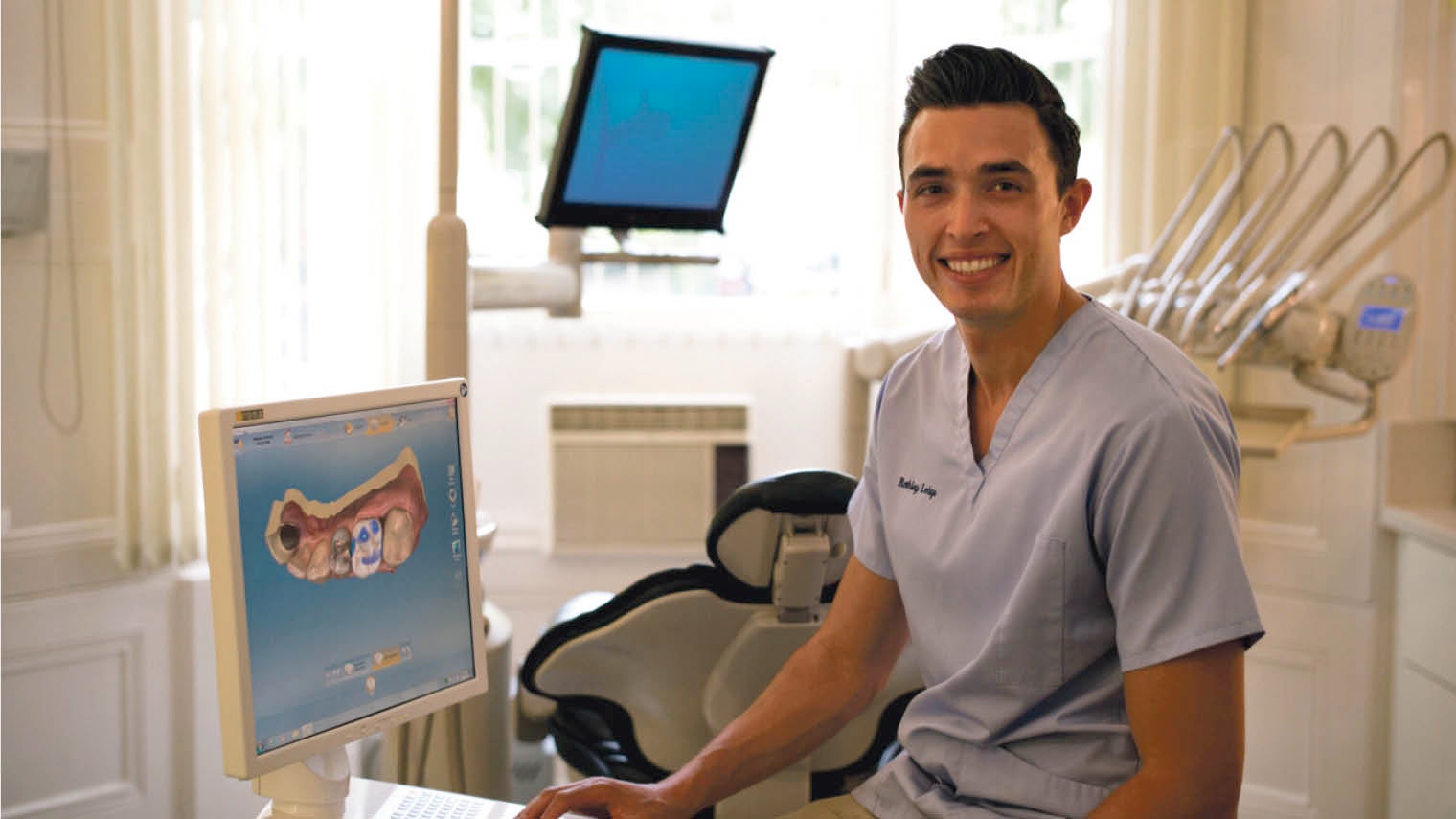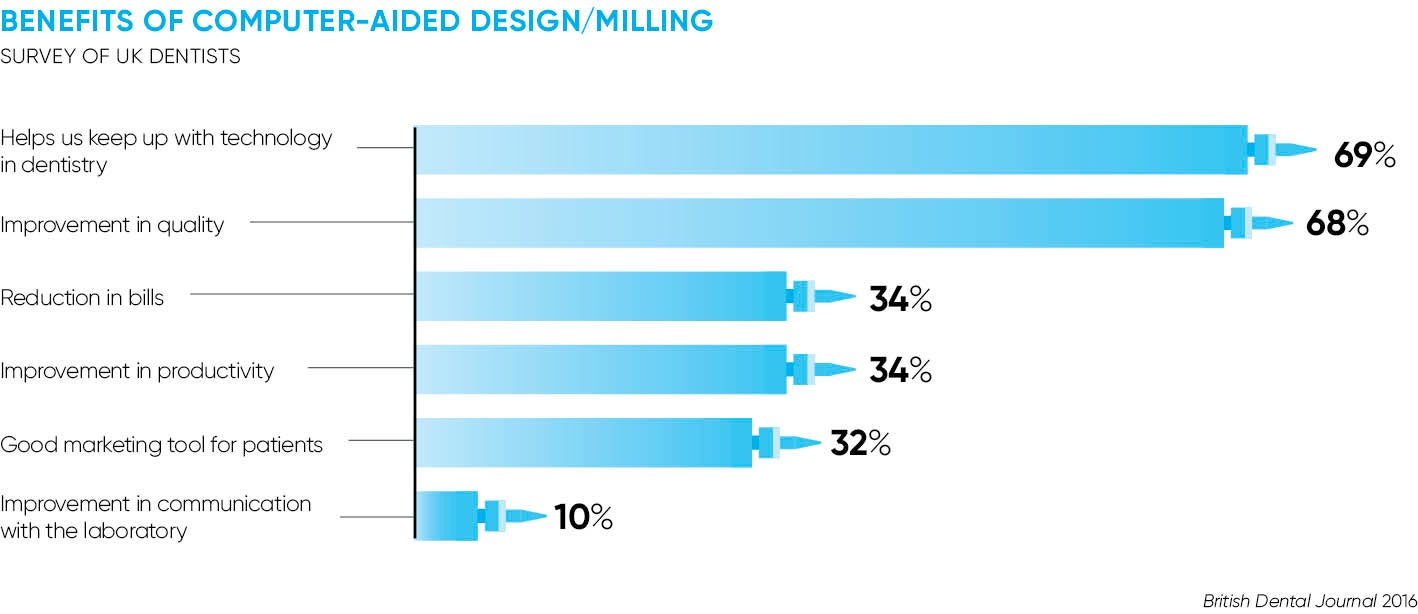The use of gypsum in dentistry can be traced back to the early-18th century to create moulds for rudimentary replacement teeth. The process has advanced to incorporate silicone, but the practice of inserting a gooey impression and fixing it manually in the mouth endures.
For many dentists, it is an archaic, industrial approach and one they are leaving behind as the profession establishes a digital presence that has been gathering pace for more than a decade.
Dentistry has long moved on from its stark past of conveyer belt filling factories treating a generation raised with poor oral health education. But surveys still show that almost half of us have a fear of the dentist with 12 per cent suffering extreme dental anxiety.

Dr Simon Chard from Rothley Lodge says the process of creating and milling a bespoke crown on site takes around two hours
Digitalisation
A wave of new dentistry seeks to cure that. It uses digital workflow systems and computer-aided design and computer-aided milling (CAD/CAM) to revolutionise protocols for implants, dentures, crowns, bridges and other oral architecture.
The traditional month-long journey for a crown fitting from moulding to delivery is being replaced by a precision-guided digitised performance that can be completed on the day.
Teeth are scanned with a wireless intraoral scanner feeding information into a computer that displays images for the patient to see and then drives a milling machine to fabricate a crown in the same room.
Early adopters are enthusiastic about their results with greater engagement for patients, who feel a part of the treatment pathway, rather than a captive audience in the dentist’s chair. But the UK lags behind Germany and the United States in uptake with estimates that digital dentistry is only available in around 15 per cent of practices and rarely on the NHS.
The capital expenditure entry costs – around £12,000 for scanning and £70,000 for milling equipment – can be prohibitive and a recent survey by the Eastman Dental Institute at University College London revealed concerns over costs, maintenance, equipment becoming obsolete, training time and a perceived lack of benefit over traditional methods.
We will see this sort of technology in every dental surgery over the next five years
“The majority of surveyed dentists were interested in incorporating CAD/CAM into their workflow, while most believed that it will have a big role in the future,” according to the survey paper in the British Dental Journal. “There are still some concerns from dentists about the quality of chair-side CAD/CAM restorations while the costs are still in the main hugely prohibitive (especially for NHS dentistry).”
However, the next generation of dentists will be digitally trained with the latest cohorts benefiting from huge investment in equipment at training schools such as the King’s College London Dental Institute, based at Guy’s Hospital.
“We are training the dentists of the future and want to future-proof their education across the 40 years of their practising lifetime,” says Dr Rupert Austin, clinical lead for digital dentistry at the Institute.
Equipping dentists with 3D scanners and displays can draw patients into their treatment. “Patients will be able to take home 3D scans of their mouth to show friends, family and children,” he adds. “The technology helps us pass more control to the patient by engaging them.”

Adoption
The main uptake has been through private dentistry, but research by the Institute has highlighted a strong return on investment with a digital cost of £21 for a restoration compared to the £200 for conventional impression materials and laboratory technician work.
“Research shows it could save NHS funds because it makes treatments better, safer, faster and it reduces the amount of time a patient spends in the dental chair,” says Dr Austin.
“There will be ‘Tommy traditionals’ who are happy with their processes, but the NHS has a strong mission to drive the uptake of digital dentistry and our trust, Guy’s and St Thomas’, is adopting the best of digital technology so the new dentists will be digital natives driving the adoption curve in the profession.
“Patients will also demand it. I have seen it in my own practice. They feel so much engaged as they see it on the touch screen, and can zoom in and out and tell their friends and family, who often then want their teeth scanned.”
Dr Simon Chard has been using digital dentistry at his Rothley Lodge practice in Staines, Surrey, for almost five years. He says: “We can do a bespoke crown using a scanner that takes 17 images a second to create a digital model the patient can see, which can be milled on site with the entire process taking around two hours. There is none of that gooey impression material that everyone hates and you don’t have to take a second day off work two weeks later for the fitting.
“I’m passionate about it because it is great for the patients and it is rewarding to see them getting excited with their dental work. No one ever got thrilled about having a gooey mould impression, but now I get patients face-timing their family when they see their new crown being made. It also helps take away that fear of the dentists.”
Dr Andrew Dawood, who runs Dawood & Tanner in central London and recently addressed the Faculty of Dental Surgery at the Royal College of Surgeons about the potential of digital dentistry, says: “There is a potential to work more efficiently across all dentistry, including the NHS, using a digital workflow.
“Cost and training are important things to get right, but I believe that we will see this sort of technology in every dental surgery over the next five years.”

Digitalisation




